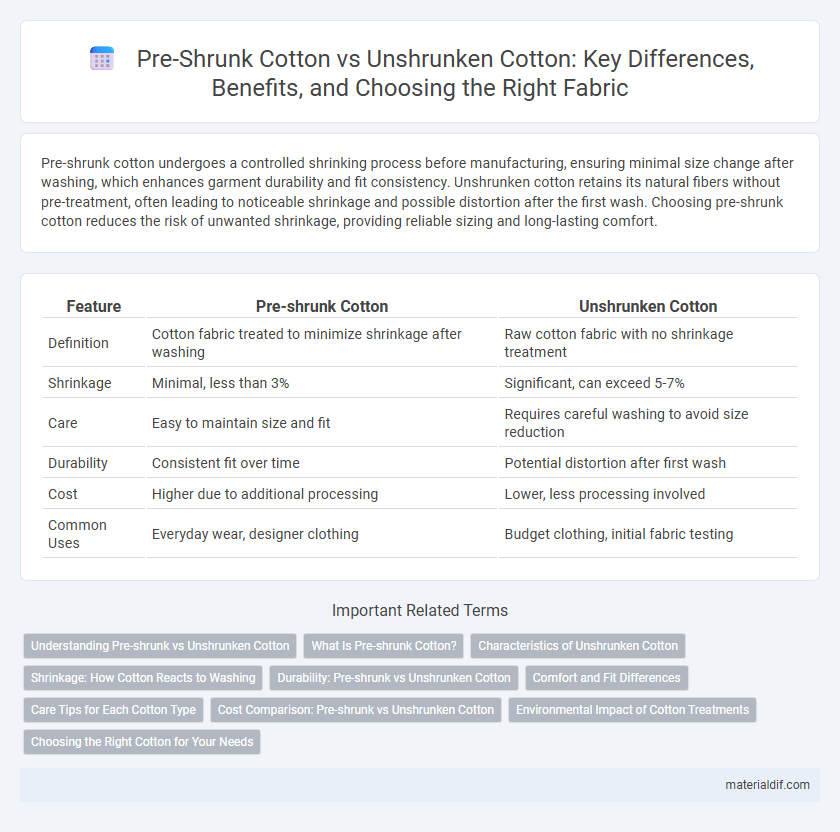Pre-shrunk cotton undergoes a controlled shrinking process before manufacturing, ensuring minimal size change after washing, which enhances garment durability and fit consistency. Unshrunken cotton retains its natural fibers without pre-treatment, often leading to noticeable shrinkage and possible distortion after the first wash. Choosing pre-shrunk cotton reduces the risk of unwanted shrinkage, providing reliable sizing and long-lasting comfort.
Table of Comparison
| Feature | Pre-shrunk Cotton | Unshrunken Cotton |
|---|---|---|
| Definition | Cotton fabric treated to minimize shrinkage after washing | Raw cotton fabric with no shrinkage treatment |
| Shrinkage | Minimal, less than 3% | Significant, can exceed 5-7% |
| Care | Easy to maintain size and fit | Requires careful washing to avoid size reduction |
| Durability | Consistent fit over time | Potential distortion after first wash |
| Cost | Higher due to additional processing | Lower, less processing involved |
| Common Uses | Everyday wear, designer clothing | Budget clothing, initial fabric testing |
Understanding Pre-shrunk vs Unshrunken Cotton
Pre-shrunk cotton undergoes a washing process during manufacturing to minimize further shrinking after purchase, ensuring garments maintain size and fit over time. Unshrunken cotton retains its natural state, which can lead to noticeable shrinkage after washing and drying, often up to 5-10% in size reduction. Choosing pre-shrunk cotton offers better dimension stability, making it ideal for consistent sizing in clothing production.
What Is Pre-shrunk Cotton?
Pre-shrunk cotton is fabric that has been treated during manufacturing to reduce shrinkage after washing, ensuring the garment maintains its size and fit. This process typically involves washing and drying the cotton before cutting and sewing, stabilizing the fibers and minimizing further shrinkage. Pre-shrunk cotton is preferred for clothing because it offers more reliable sizing and reduces the risk of distortion after laundering compared to unshrunken cotton.
Characteristics of Unshrunken Cotton
Unshrunken cotton retains its natural fiber length and tensile strength, offering a softer and more breathable fabric compared to pre-shrunk cotton. It exhibits higher dimensional variability, which means garments made from unshrunken cotton may experience significant size reduction after the first wash. This natural shrinkage is ideal for products where softness and durability are prioritized over consistent fit.
Shrinkage: How Cotton Reacts to Washing
Pre-shrunk cotton undergoes a mechanical or chemical process to minimize shrinkage, ensuring that garments retain their original size after washing. Unshrunken cotton naturally contracts when exposed to water and heat, often resulting in noticeable size reduction, typically around 3-5%. Understanding the difference in shrinkage behavior between pre-shrunk and unshrunken cotton is essential for selecting fabrics that maintain fit and durability over time.
Durability: Pre-shrunk vs Unshrunken Cotton
Pre-shrunk cotton undergoes a treatment process to minimize fabric shrinkage, resulting in enhanced dimensional stability and consistent fit after washing, which contributes to its long-term durability. Unshrunken cotton, lacking this treatment, tends to shrink and deform more noticeably, potentially weakening fabric fibers and reducing garment lifespan. Choosing pre-shrunk cotton ensures fabrics maintain structural integrity and resist wear, making it a superior option for durability-conscious consumers.
Comfort and Fit Differences
Pre-shrunk cotton undergoes a controlled shrinking process before manufacturing, ensuring consistent fit and reducing fabric distortion after washing, which enhances comfort by maintaining garment shape. Unshrunken cotton retains its natural fibers without pre-treatment, leading to potential post-wash shrinkage that may alter fit and cause tighter, less comfortable wear over time. Choosing pre-shrunk cotton guarantees a stable size and soft texture, optimizing overall comfort and wardrobe reliability.
Care Tips for Each Cotton Type
Pre-shrunk cotton fabrics offer durability and reduced shrinkage after washing, requiring care with cold water and gentle cycles to maintain their shape and softness. Unshrunken cotton needs careful handling with lukewarm water and air drying to prevent significant shrinkage, as it retains natural fibers more susceptible to size changes. Both types benefit from avoiding high heat in drying and ironing to prolong fabric integrity and comfort.
Cost Comparison: Pre-shrunk vs Unshrunken Cotton
Pre-shrunk cotton generally costs more than unshrunken cotton due to the additional processing steps required to minimize fabric shrinkage. This treatment ensures dimensional stability, reducing future alterations and wear, which can offset the higher upfront price. Unshrunken cotton is cheaper initially but may lead to increased costs over time from size changes and garment distortions after washing.
Environmental Impact of Cotton Treatments
Pre-shrunk cotton undergoes chemical and heat treatments that can increase water usage and introduce harmful substances into wastewater, impacting ecosystems negatively. Unshrunken cotton, while requiring consumers to manage shrinkage, avoids these additional processing steps, resulting in a lower environmental footprint during manufacturing. Choosing unshrunken cotton supports reduced chemical runoff and water consumption, contributing to more sustainable textile production.
Choosing the Right Cotton for Your Needs
Pre-shrunk cotton fabrics undergo a controlled shrinking process to minimize additional shrinkage after washing, making them ideal for garments requiring consistent sizing and fit. Unshrunken cotton retains its natural fibers without treatment, allowing for potential size changes but offering a softer, more breathable texture preferred in casual or artisanal clothing. Selecting between pre-shrunk and unshrunken cotton depends on your priority for garment durability and fit stability versus comfort and natural fiber qualities.
Pre-shrunk Cotton vs Unshrunken Cotton Infographic

 materialdif.com
materialdif.com